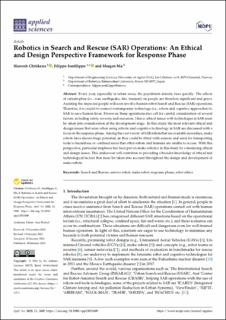Robotics in Search and Rescue (SAR) Operations: An Ethical and Design Perspective Framework for Response Phase
Peer reviewed, Journal article
Published version
Permanent lenke
https://hdl.handle.net/11250/3115989Utgivelsesdato
2023Metadata
Vis full innførselSamlinger
Originalversjon
Chitikena, H., Sanfilippo, F. & Ma, S. (2023). Robotics in Search and Rescue (SAR) Operations: An Ethical and Design Perspective Framework for Response Phase. Applied Sciences, 13(3), 1-23. https://doi.org/10.3390/app13031800Sammendrag
Every year, especially in urban areas, the population density rises quickly. The effects of catastrophes (i.e., war, earthquake, fire, tsunami) on people are therefore significant and grave. Assisting the impacted people will soon involve human-robot Search and Rescue (SAR) operations. Therefore, it is crucial to connect contemporary technology (i.e., robots and cognitive approaches) to SAR to save human lives. However, these operations also call for careful consideration of several factors, including safety, severity, and resources. Hence, ethical issues with technologies in SAR must be taken into consideration at the development stage. In this study, the most relevant ethical and design issues that arise when using robotic and cognitive technology in SAR are discussed with a focus on the response phase. Among the vast variety of SAR robots that are available nowadays, snake robots have shown huge potential; as they could be fitted with sensors and used for transporting tools to hazardous or confined areas that other robots and humans are unable to access. With this perspective, particular emphasis has been put on snake robotics in this study by considering ethical and design issues. This endeavour will contribute to providing a broader knowledge of ethical and technological factors that must be taken into account throughout the design and development of snake robots.

